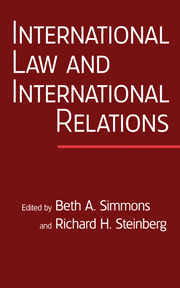Book contents
- Frontmatter
- Contents
- Contributors
- Abstracts
- Preface
- Editors' Note
- PART I INTERNATIONAL REGIMES THEORY: DOES LAW MATTER?
- PART II COMMITMENT AND COMPLIANCE
- PART III LEGALIZATION AND ITS LIMITS
- PART IV INTERNATIONAL LAW AND INTERNATIONAL NORMS
- PART V TREATY DESIGN AND DYNAMICS
- 13 Why Are Some International Agreements Informal? (1991)
- 14 The Politics of Dispute Settlement Design: Explaining Legalism in Regional Trade Pacts (2000)
- 15 Loosening the Ties that Bind: A Learning Model of Agreement Flexibility (2001)
- 16 Driving with the Rearview Mirror: On the Rational Science of Institutional Design (2001)
- 17 The Dynamics of International Law: The Interaction of Normative and Operating Systems (2003)
- PART VI LAW AND LEGAL INSTITUTIONS
- PART VII OTHER SUBSTANTIVE AREAS OF INTERNATIONAL LAW
- References
- Index
16 - Driving with the Rearview Mirror: On the Rational Science of Institutional Design (2001)
Published online by Cambridge University Press: 05 June 2012
- Frontmatter
- Contents
- Contributors
- Abstracts
- Preface
- Editors' Note
- PART I INTERNATIONAL REGIMES THEORY: DOES LAW MATTER?
- PART II COMMITMENT AND COMPLIANCE
- PART III LEGALIZATION AND ITS LIMITS
- PART IV INTERNATIONAL LAW AND INTERNATIONAL NORMS
- PART V TREATY DESIGN AND DYNAMICS
- 13 Why Are Some International Agreements Informal? (1991)
- 14 The Politics of Dispute Settlement Design: Explaining Legalism in Regional Trade Pacts (2000)
- 15 Loosening the Ties that Bind: A Learning Model of Agreement Flexibility (2001)
- 16 Driving with the Rearview Mirror: On the Rational Science of Institutional Design (2001)
- 17 The Dynamics of International Law: The Interaction of Normative and Operating Systems (2003)
- PART VI LAW AND LEGAL INSTITUTIONS
- PART VII OTHER SUBSTANTIVE AREAS OF INTERNATIONAL LAW
- References
- Index
Summary
How can social scientists best contribute to the design of international institutions? Presumably our value lies in producing knowledge about design that those designing institutions need but do not have. But what kind of knowledge is that? What should a science of institutional design be “about?”
As a discipline international relations (IR) has barely begun to think about institutional design. Anarchy makes the international system among the least hospitable of all social systems to institutional solutions to problems, encouraging actors to rely on power and interest instead. Skeptics may be right that all this activity is unimportant but policymakers apparently disagree. And that in turn has left IR with less to say to them than it might have. By bracketing whether institutions matter and turning to the problem of institutional design, therefore, this volume takes an important step toward a more policy-relevant discourse about international politics.
The articles in this volume deserve to be assessed on their own terms, within the particular rationalist framework laid out in Barbara Koremenos, Charles Lipson, and Duncan Snidal's introduction. That framework highlights collective-action problems and incomplete information as impediments to institutional design. However, offering an internal critique of the Rational Design project from any rationalist perspective is not something I am particularly qualified or inclined to do, nor was it the charge given to me when I was generously invited to contribute.
- Type
- Chapter
- Information
- International Law and International RelationsAn International Organization Reader, pp. 403 - 425Publisher: Cambridge University PressPrint publication year: 2007



